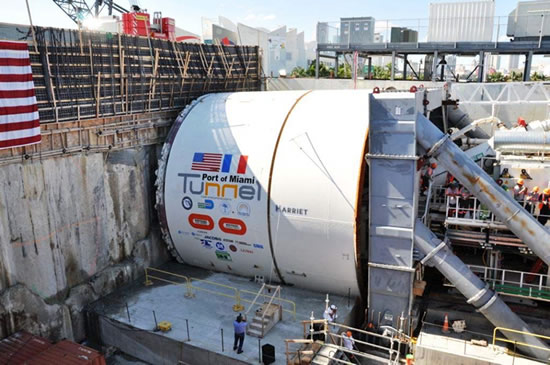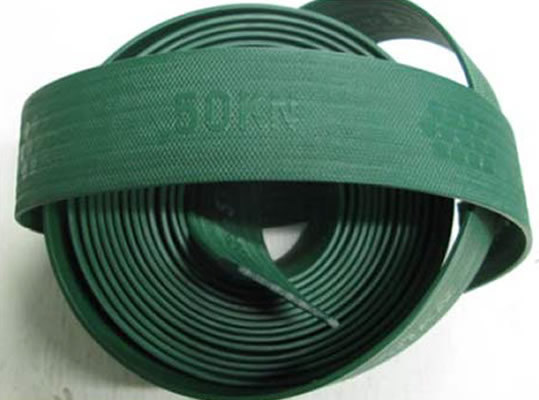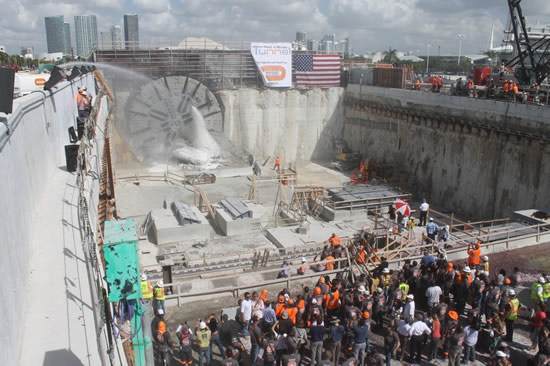


The Florida Department of Transportation’s impressive tunnel project has connected the Port of Miami directly with US Interstate’s 395 and 95. The well-publicized work has been designed to alleviate cargo-related congestion created by the busy port and to reduce the amount of cargo-carrying vehicles throughout the city’s downtown districts. The success of the project has been secured through the use of geosynthetic strip reinforcement.
A UNIQUE GEOSYNTHETIC STRIP REINFORCEMENT APPLICATION
The Tunnel Boring Machine (TBM) used on the Port of Miami project required overburden to functionally operate by maintaining the necessary downward pressure over the cutter head. A launching pit was excavated to create a vertical face for the TBM to start drilling; however, due to site constraints, it could not be positioned deep enough at the break‐in point to provide the required overburden.
A temporary wire faced Reinforced Earth® wall using GeoStrap® geosynthetic strip reinforcement was designed and built on top of the break‐in point to raise the finish grade above the cutter head; hence, providing the required overburden for the TBM and acting as break‐in and break‐out walls.
GeoStrap® is composed of high tenacity polyester fibers encased in a polyethylene sheath. This is the first mechanically stabilized earth (MSE) wall application that has been used in this manner.
Adding to the overburden pressure was the use of a cement‐ treated backfill material, specifically chosen due to its weight and strength, and the ability to support itself once the material was set.
The Port of Miami tunnel project also specified the geosynthetic strip reinforcement because it enabled the TBM to easily bore through the reinforced soil mass. The combined use of a vertical wire faced Reinforced Earth® wall and a self‐standing backfill material also allowed the steel face of the wall to be removed just prior to the TBM break‐in. This was obtained by cutting the GeoStrap® strips where they wrapped around connector rods. By removing the steel wire facing panels, the cutter head did not have to cut through any steel, which prevented damage to the cutting elements.
These overburden Reinforced Earth® walls were successfully installed and performed as designed for both the break‐in and break‐out points.
PERMANENT MSE WALLS IN HIGH PH ENVIRONMENT
Adjacent permanent Reinforced Earth® walls using EcoStrap™ were also part of the project. Because the use of this type of geosynthetic strip reinforcement does not impose any limitation on the allowable concentration in salts nor on the pH level for the corresponding backfill material, this solution was particularly suited to fit with the project’s constraints. EcoStrap™ reinforcements are geostrips composed of compact bundles of polyvinyl alcohol (PVA‐L) yarns protected by a polyethylene sheathing.
Manufactured by extrusion‐coating, the selected PVA‐L yarns conform to strict standards, thus providing an excellent durability in all types of conditions and environments, including high alkaline environments (pH up to 13). EcoStrap™ reinforcements are insensitive to the presence of salts in the backfills and are particularly adapted, as indicated, to highly alkaline backfills such as lime‐ and cement‐treated fills, or fills made of recycled aggregates containing crushed concrete. It was demonstrated that the PVA‐L yarns do not exhibit any degradation in these types of environments and for the service duration expected from Reinforced Earth® structures.
GEOSYNTHETHIC ENGINEERING IN PORT & COASTAL APPLICATIONS
Land use is often at a premium in ports and along coastal areas just above high water or normal flood stage elevation. This proximity to marine environments can pose technical challenges leading to costly alternatives when the river bank or seacoast is so narrow that new construction encroaches into the waterway. Under such conditions, retaining structures are required which will be in permanent or temporary contact with either fresh or salty water. Furthermore, the combined forces of water and water borne debris during storms or floods represent additional structural considerations that need special attention when designing retaining structures.
The use of geosynthetic reinforcements has seen a distinctive growth in the number of these types of MSE structures, particularly in saltwater applications. The materials used in the reinforcements are typically composed of high tenacity polyester (PET), polyethylene (PE), polypropylene (PP) or polyvinyl alcohol (PVA).
Whether designed as a permanent structure exceeding a 75-year design life or as a temporary structure designed to serve less than 3 years, geosynthetic-reinforced MSE structures are a proven and effective system applicable to port and coastal structures such as retaining walls, quay walls, and other port authority‐related construction. The use of MSE structures offers significant cost savings, design flexibility and rapid construction. Supported by a track record of more than 50 years, reinforced soil structures designed by Terre Armée have demonstrated superior performance in almost any application, whether on dry land or submerged in water.
Learn more about Terre Armee’s engineered reinforcement systems, MSE applications with geosynthetics, and more at www.terre-armee.com.











